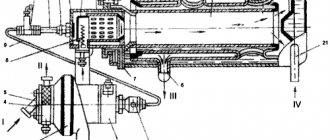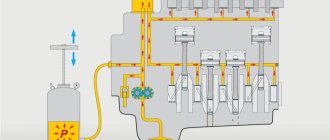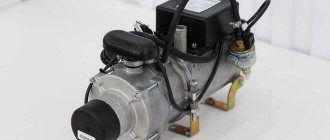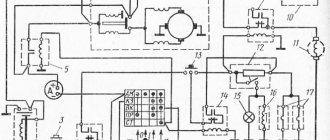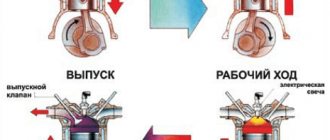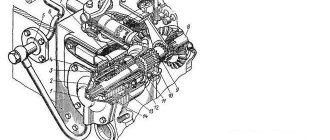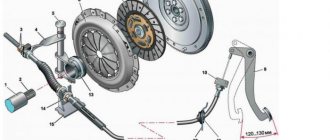Most foreign automobile concerns, trying to conquer the Russian market, supply car models with a pre-installed engine pre-heater. This function is especially popular in regions with long winters. You can install such a heater on almost any car - just purchase the device and contact a service center for help. The main issue remains the efficiency of the equipment and the return on funds spent on its purchase and installation.
What is a pre-heater?
The main function of the preheater is to warm up the car engine without a cold start. Depending on the principle of operation and general purpose, the device may have different power and dimensions. In addition to warming up the engine, its functionality also includes heating the windshield, wipers and interior. The design of autonomous equipment is quite simple and includes a radiator, boiler, combustion chamber, pumps designed to pump coolant and fuel, and a fuel supply system. You can also add an electronic control unit, a thermal relay and a device starter here.
Installation
Installation diagram Binar-5
The simplest electric heaters are easy to install - drain the antifreeze, cut out a section of the lower radiator pipe to the required length, insert the heater into the cut pipe, tighten the clamps and refill the antifreeze. All that remains is to stretch the wires so that the car can be easily “connected to the outlet.”
Why does the electric heater cut into the lower pipe? This speeds up heating due to thermal convection - heating systems without forced circulation work the same way. When inserted into the upper pipe, the antifreeze is heated in the radiator, and not in the engine - a closed thermostat will not allow the liquid to flow into the block by convection.
Operating principle of the Webasto liquid heater
You can start the device using a cell phone, remote control, or automatically using a timer. The electronic unit, receiving a start impulse, activates the executive motor, which, in turn, starts the fan and fuel pump. Fuel is pumped into the burner by a pump, which is converted into an air-fuel mixture thanks to a glow pin and an evaporator.
The fuel mixture enters the combustion chamber, where it is ignited by a spark from the spark plug. The resulting heat is supplied to the working fluid of the cooling system. The booster pump forces the liquid to move along the cooling circuit, which also includes the preheater. During the circulation process, heat from the liquid is transferred to the engine housing.
After the coolant warms up to 30 degrees, the radiator fan turns on. Warm air is forced into the car interior. After heating the antifreeze to 72 degrees, the heater switches to an economical operating mode; when the antifreeze cools to 56 degrees, the heater starts again. In fact, the design and operating principle of the preheater are in many ways similar to a car interior heater.
The heater has certain advantages, for example, a remote control function. It can be started by pressing the button located on the key fob, and it will warm up the car by the time the driver arrives. On average, the temperature will rise in half an hour, which allows you to start the engine without any problems.
Models, their features
The “Start” line of preheaters includes the following series:
"Start"
Classic horizontal tank-type heaters with high power (2.5 and 3.0 kW). The movement of liquid in them is gravity. Designed for installation on trucks;
"Start-Turbo"
The only series of tank heaters equipped with a centrifugal pump providing forced circulation. They are mounted on the car in a vertical position, the terminals for connecting to the system are located perpendicularly. The series includes three sets - “Universal No. 1” (with a power of 1.0 kW, 1.5 kW and 2.5 kW.
The set contains components for a sequential installation method), “Universal No. 2” (heaters of the same power, but the set contains a variety of elements for installation, which allows you to make an insert in different ways) and “Universal No. 3” (the kit contains the same components, same as set No. 1, but the device itself is different - its power is 3 kW). These devices are suitable for use on both cars and trucks;
"Start-Classic"
Vertical gravity tank heaters. Models are available with two powers - 1.5 and 2.0 kW. They are intended for use on passenger car engines;
"Start M"
Gravity reservoir devices having a horizontal design. The power of the devices is 1.5 and 2.0 kW. They are intended for mid-size GAZ and ZIL trucks, but are often used by owners of passenger cars. One of the models is equipped with a bumper connector;
"Start M1" and "Start M2"
Low-power flow-type heaters. Models M1 (power 0.6 kW) are designed for installation on VAZ engines (the design of the cooling system of which uses a shortened supply pipe). And M2 heaters are designed for use with GAZ car engines. Their power is 0.7 kW;
"Start MP"
A series of low-power flow-through heaters (0.7 kW). Includes three models that differ in the diameters of the connection pins (26 mm, 32 mm and 39 mm). This series is suitable for use on cars, trucks and any other vehicles with a liquid cooling system (for example, snowmobiles);
Each heater model is equipped with everything necessary (adapters, tees, mounting brackets, clamps, rubber tubes) for installation work. There are also options when devices are sold without any additional components in the set.
To maintain the temperature regime, thermal switches are used in the design of the heaters, which eliminates the possibility of overheating of the heating element and its failure.
Electric engine heater
An electric engine heater is an alternative version of the device described above, powered by an external power supply and installed in the cylinder block. The main element of such a design is an electric spiral, which is mounted in the cylinder block. First, the anti-ice plug is removed from it, the place of which is taken by a spiral. Antifreeze is heated by a spiral, then circulates in the cooling system. The efficiency of such a system is somewhat lower, and warming up takes longer.
It is optimal to use such a device in parking lots and garages with access to an electrical outlet. The disadvantage of an electric heater is its high power consumption. Saving electricity is possible thanks to the built-in timer, which turns off the device after the liquid reaches a certain temperature.
The electric heater option includes:
- Possibility of heating the car interior;
- Heating the working fluid in the cooling system of the power unit;
- Battery charge.
How the system works
If the car is not used for a long time in frosty weather, the engine oil, which serves as the main substance to prevent wear of parts, hardens. In these cases, antifreeze heating is used. Installing such a device is quite simple, so car owners most often do it themselves.
When choosing an electric heater, the type, size or displacement of the engine is taken into account.
All types of preheating work on almost the same principle. Through a small hole, the antifreeze enters the heating system, the temperature of the antifreeze rises, and then it passes through the outlet hole directly to the engine. Electric heating of the antifreeze is carried out in the housing, gradually circulating, thereby heating all the antifreeze. The maximum temperature is 70 degrees.
The use of an antifreeze heater with electricity has become most popular in Europe, and since the late 90s of the last century in the post-Soviet space. This is a more economical, safer way to warm up the engine.
, which uses electrical energy rather than gasoline. An external power supply of 220 V is used for operation.
One of the main advantages of an electric heater is its silent operation, as well as the presence of a special relay that will prevent overheating of the coolant.
It is convenient to turn on such a device at night and be sure that it works reliably, with increased safety for the car.
The heating system must be installed so that antifreeze easily finds its way to and from the heating system to ensure smooth circulation. The heater is installed in the body on the left side.
Tips for use:
- The part is placed as low as possible, but above the engine protection placed.
- Up to 300 ml of a special substance is pre-filled into the heating device.
- The antifreeze is drained from the engine.
How to install a heating system yourself
The part is placed on the bracket on the left inside the body, then a piece of pipe is inserted into the inlet hole, which is securely tightened with a clamp. The other end of the pipe is pulled to the removed drain plug, a fitting lubricated with a hermetic substance is put on, and unscrewed together with the drain plug.
Afterwards, the thick pipe is removed, which needs to be divided in half. The pipes are put on the hermetically lubricated tee, the clamp rings are tightened tightly, and the pipe is reinstalled. Then the antifreeze is refilled and the car starts. After a while, the engine begins to heat up, reaching the temperature required for operation.
Advantages of engine preheaters
An engine pre-heater is a device necessary for easy and quick starting of a car’s power unit in the winter. The use of heaters can extend engine life and increase efficiency. This is achieved through:
- Reducing the number of cold engine starts. Every year, on average, each driver makes about 300-500 cold starts of the power unit. The heater allows you to reduce fuel consumption per cold start by 100-500 ml. Fuel economy largely depends on the duration of engine warm-up and ambient temperature.
- Reduced engine wear. The maximum level of wear of the power unit occurs during the startup period. This is explained by the fact that the viscosity of cold engine oil is lower, and accordingly, it is not able to provide sufficient lubrication of parts. Friction increases, which increases wear on engine components.
- Increasing the comfort and safety of driving a car. Cold weather has a negative impact on driver alertness, increasing drowsiness and fatigue. As a result, this can affect your driving style and lead to dangerous situations on the road.
Is it really necessary?
Do not underestimate such devices: in severe frosts, a diesel engine will not start without it, so their presence makes life easier for drivers. The heater present in the truck not only helps to start the engine, but also warms up the cabin. Starting difficulties arise even at the slightest frost, as the viscosity of the lubricant and fuel increases.
It’s up to you to decide whether to bet or not, but if the frost in your region exceeds -5, there’s nothing to argue about, just bet and that’s it.
When choosing diesel preheaters for passenger cars, you need to pay attention to their quality and characteristics. Choosing a device based on cost is a huge mistake, typical for beginners; saving forces you to pay twice, and a high price does not guarantee quality. The video shows a budget option from China
Advantages of the Webasto heater compared to car alarms with auto start
Compared to remote car alarms, the Webasto engine preheater can be installed on a car of any make and model. This, in fact, is its main advantage. In addition to this, the following advantages can be noted:
- A remote car alarm requires that one of the keys remain inside the car, which risks its theft.
- Starting the engine using a remote alarm can cause early engine wear. On average, one cold engine start is equal to a thousand starts at positive ambient temperatures.
The coolant temperature in the case of a diesel engine does not rise above 50 degrees; accordingly, it will be difficult for any climate control system to raise the interior temperature to a comfortable one. Webasto, unlike similar systems, is able to warm up the interior in a short time and maintain an optimal temperature, since when the temperature drops while the engine is running, it will turn on automatically, maintaining the set temperature.
The Webasto preheater is selected based on the technical characteristics of the car, its features and the personal preferences of the owner. Such systems are usually installed in service centers for a reasonable fee.
For cars with an engine capacity of up to 2 liters, choose the Webasto Thermo Top Evo 4 heater, the heating power of which is 4 kW. If the engine volume is more than 2 liters, then install Webasto Thermo Top Evo 5, whose power is 5 kW.
Connection rules
To correctly install this device during work, you should follow the manufacturer’s instructions. Some models have nuances during installation. They should be taken into account. In most cases, it is enough to allocate 1.5 hours of free time to properly install the device for heating antifreeze in winter. Before starting work, you need to stock up on a canister of this technical fluid, since during the manipulations you will have to carry out the procedure of draining the old antifreeze.
First, you should drive the car to the inspection hole and remove the filled liquid from the system. When this work is completed, you can move on to the main steps for installing the heater. Before this, it is necessary to carry out the procedure of flushing the cooling system channels. It is best to use hot water for this.
Next, you need to check whether the car has a coolant drain valve. If this element is present, then it is worth using it. In some machines it is not provided by the manufacturer. Then you need to find the technological plug, which is located in the engine compartment. Often it can be found directly on the power unit block. It must be unscrewed, after which the fitting should be removed.
The fitting should be inserted into the hole in the engine. However, during this operation there is a high risk that the pads may fall out. To avoid this, you should use a heat-resistant silicone-based sealing material.
If the car has a special tap for draining antifreeze, then the steps listed above are performed in a similar way. Then you need to install the heater in its place and then secure it. After this, you should connect the device inlet and the liquid intake point into a single whole. To solve this problem you will need a hose. Reliable fastening of the elements is ensured if you use conventional clamps.
Next, you need to connect the installed device to the power unit. This manipulation should be performed in such a way that the outlet is located at the site of the hose rupture. After this, the next step is to connect the tee. It is secured using conventional sealant. For greater reliability, you can use clamps.
The hose that will be laid from the heater directly to the tee should not have any bends. This means that it is necessary to lay it in the shortest possible way. Otherwise, you may encounter cracks, which will provide poor heat transfer. Next, the hose must be secured to the connected device, and the other side must be installed in the internal combustion engine.
